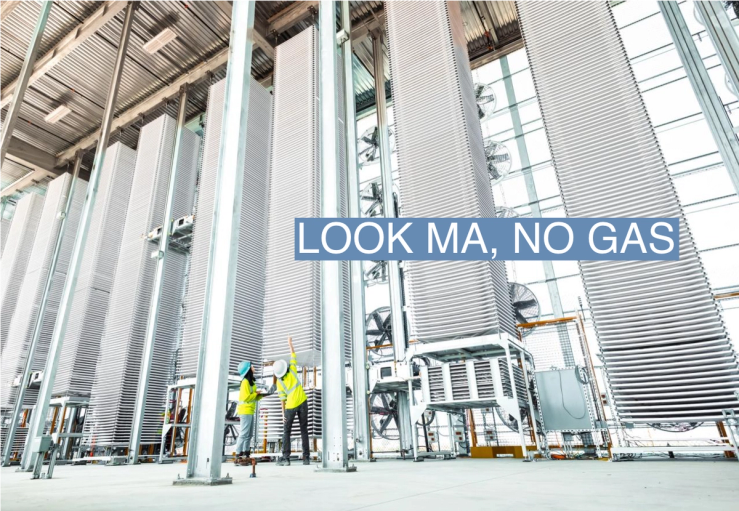The News
Two major projects last week showcased the growing ambition of the direct air-capture sector. First, BlackRock announced a $550 million investment in what will apparently be the world’s largest such facility, developed by the oil and gas company Occidental in Texas. Then the startup Heirloom unveiled what it said was the U.S.’s first commercial DAC site in California.
Both projects also illustrate a rift in the nascent industry over its relationship with fossil fuels, as it grapples with how it should — or shouldn’t — utilize, partner with, or ignore an industry it and others blame for driving climate change.
On one end lies Occidental, which will use some of its DAC sites to facilitate more oil and gas extraction. On the other is Heirloom, which last month published a manifesto of sorts in which it largely ruled out working with the oil and gas industry.
Prashant’s view
This debate is as much about moral and philosophical questions as technical and financial ones.
One of the biggest obstacles to expanding DAC — which scientists see as essential for mopping up existing atmospheric emissions — is its cost, which today can range upward of $1,000 per ton. To bring that down, DAC entrepreneurs need to grapple with thorny questions about their own use of fossil fuel-based electricity, which may be the cheapest option in some cases. They also need to confront the most obvious way to turn captured carbon dioxide into revenue, which is to sell it to oil companies that use it to push the last drops out of wells, a process known as enhanced oil recovery. The fossil-fuel industry also has long invested in the capture and transport of carbon, is filled with key expertise, and is deep pocketed, making it a potential partner.
Some DAC startups are comfortable working alongside oil and gas majors, utilizing their existing infrastructure and cheap energy to display commercial viability and scale up while still sucking more carbon emissions out of the atmosphere than they emit. But for others, that approach is both morally compromised and a deterrent to investors.
“It’s both easy and not,” Marcus Lima, the co-founder and chief executive of DAC startup Heimdal, said of his decision for his company to use natural gas both as an energy source and in enhanced oil recovery. “You have to recognize there is a lot of emotion related to this because [fossil-fuel companies] are ultimately responsible for extracting the fuels that we use and created this problem.”
But, he said, DAC companies needed to scale quickly, and should not be “holding ourselves to these ridiculous standards that make things uneconomic and make them happen slow.” He continued: “As long as we do it responsibly, making sure that we are in line with that mission of maximizing net tons of CO2 being removed as quickly as possible, I think we should use all means available to us.”
Yet as he noted, the argument is far from straightforward. For one, some investors do not want to put money into projects that benefit oil and gas companies in any way — whether as customers, suppliers, or partners — or do not want to be party to enhanced oil recovery, worried that such efforts prolong the use of fossil fuels.
Heirloom uses renewable electricity and avoids the oil market by selling top-dollar carbon removal credits to companies like Microsoft. The company’s head of climate policy Vikrum Aiyer also noted that its refusal to work on enhanced oil recovery, accept fossil fuels investment or board representation, or subsidize its technology with fossil fuel revenues helped with recruitment and with winning over local communities where it aims to build its facilities.
Still, Aiyer told me that Heirloom would consider “partnerships on the workforce side” involving companies with geological, logistical, or carbon-storage expertise: “The same folks who are very savvy at pulling things from under the ground are probably pretty darn good at putting things back into it.”
Ultimately, the viability of higher-cost, oil-avoiding DAC ventures will depend on the availability of enough deep-pocketed carbon-credit buyers to keep the industry growing while it reaches the necessary scale to compete on cost with the likes of Occidental.
Quotable
“I understand the argument that getting to scale really matters. And I think that’s an argument we subscribe to. Maybe it’s just about where you put the line. I also don’t think it’s completely black and white. [But] I think in the case of energy source, it’s such a fundamental topic, where your technology needs to have solved this before you scale. And you need to have solved the pathway — how to use zero carbon energy — before you start scaling.”
— Andreas Aepli, chief financial officer of Climeworks, which uses renewable energy to power its DAC facilities.
Know More
DAC will play “an important and growing role” in pathways to net zero, according to the International Energy Agency, particularly in balancing emissions from hard-to-abate sectors such as heavy industry or air travel, and for legacy emissions in the atmosphere.
The economics of the industry have been transformed by the U.S.’s Inflation Reduction Act, which offers a $180 tax credit for each tonne of CO2 permanently removed and stored, and outlines a long-term pathway for the sector to expand, allowing any facility which begins construction before 2033 to avail of the financial support.
Room for Disagreement
To its critics and skeptics, focusing on the DAC sector at all is a sideshow, providing cover to continued burning of fossil fuels and distracting from the core task of urgently reducing overall emissions. All of the DAC executives I spoke to themselves agreed that their industry could not, and should not, stand in for emissions reductions.
The debate about whether or not to use natural gas may also ultimately be a short-term one: the price of established renewables technologies such as wind and solar are already so low that over time, they will likely become the default source of power anyway.


